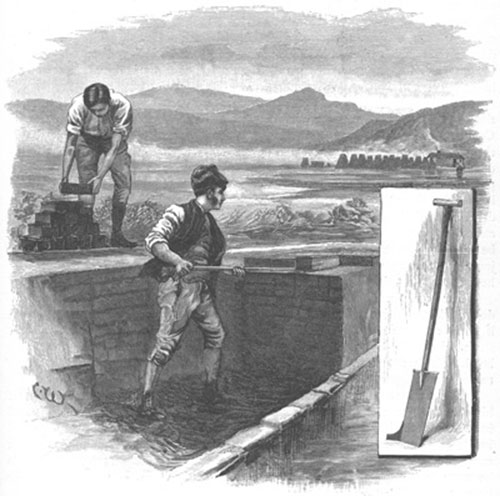Peat Cutting in the Bog of Allen - Irish Pictures (1888)
From Irish Pictures Drawn with Pen and Pencil (1888) by Richard Lovett
Chapter VII: Connemara … continued
« Previous Page | Start of Chapter | Book Contents | Next Page »
But most visitors, after seeing Moher, prefer to leave these tamer beauties for the more rugged scenes of the north, and make all speed to Galway. Or, if coming from Dublin, they will take the comfortable and, for Ireland, fast express of the Midland Great Western Railway. By this route the visitor runs across the great central plain of the country, and over the extensive dreary tracts of the Bog of Allen, which at parts extends for miles along both sides of the railway. But even here the dark brown colouring, the dead level, the evidences of peat cutting, and the accentuated monotony of the landscape, combine to interest those who see them for the first time. These peat bogs make up a very considerable proportion of the soil of the country, occupying no less than 2,830,000 acres, and they arouse curiosity as to their origin. Since, like coal, they exhibit no marine fossils, they are not due to the action of the sea. But the evidence shows that they have been formed by mossy growths either in forests or upon the sediment deposited in hollows or fresh-water lakes. The continuous growth and decay during the lapse of ages has slowly built up the peat, which now varies from 20 to 40 feet in thickness, and which supplies over a great part of Ireland the lack of coal. The great bog district over which the railroad to Galway runs is believed to be due to the growth of peat-producing plants destroying the original oak forest, this being succeeded by firs, and these also perishing in turn.
Peat-cutting is one of the commonest and most characteristic occupations in Ireland. Our engraving illustrates the process in some parts of Connaught, though the commoner method is to cut the peat from above, the operator with the spade standing upon the portion to be cut away, and detaching the blocks vertically, not horizontally. The peat is cut into pieces much the size and shape of a brick. It is piled in the first instance loosely by the side of the trench from which it is cut. When sufficiently dried there, it is stacked, as shown by the piles in the distance, and it is then carried or carted by horses, ponies or donkeys to the place where it is to be sold or consumed. Most travellers in Ireland at some stage of their journeyings have reason to, and very readily can, assure themselves of the heat-giving qualities of peat.
« Previous Page | Start of Chapter | Book Contents | Next Page »

